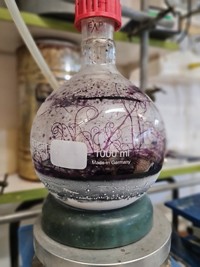Advertisement
Grab your lab coat. Let's get started
Welcome!
Welcome!
Create an account below to get 6 C&EN articles per month, receive newsletters and more - all free.
It seems this is your first time logging in online. Please enter the following information to continue.
As an ACS member you automatically get access to this site. All we need is few more details to create your reading experience.
Not you? Sign in with a different account.
Not you? Sign in with a different account.
ERROR 1
ERROR 1
ERROR 2
ERROR 2
ERROR 2
ERROR 2
ERROR 2
Password and Confirm password must match.
If you have an ACS member number, please enter it here so we can link this account to your membership. (optional)
ERROR 2
ACS values your privacy. By submitting your information, you are gaining access to C&EN and subscribing to our weekly newsletter. We use the information you provide to make your reading experience better, and we will never sell your data to third party members.
Synthesis
Gold Complex Changes Color Reversibly
Grinding and exposure to solvents trigger phase transformations and color changes
by Sophie L. Rovner
July 17, 2008
Gentle grinding of a new Au(I) complex in solid form changes its luminescence behavior, Japanese researchers report. UV light reveals the induced change in the compound as it goes from blue to yellow (a). The color change, which isn't apparent in visible light (b), can be reversed by exposing the fully ground powder (c) to drops of dichloromethane or other solvents (d). Powder turned completely blue by solvent (e) reverts to yellow after the solvent evaporates and the solid is again ground with a pestle (f).
Chemists Hajime Ito, Masaya Sawamura, and colleagues at Hokkaido University, in Sapporo, detected no degradation in luminescence even after 20 cycles of blue-to-yellow conversion of the [(C6F5Au)2(μ-1,4-diisocyanobenzene)] complex (J. Am. Chem. Soc., DOI: 10.1021/ja8019356).
X-ray and IR studies suggest that grinding transforms the more stable crystalline blue phase into an amorphous yellow phase and alters the coordination of the isocyanide ligands to the gold atoms. Such compounds could be used in recording and sensing devices, the authors propose.






Join the conversation
Contact the reporter
Submit a Letter to the Editor for publication
Engage with us on Twitter